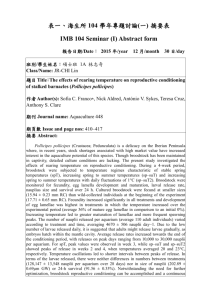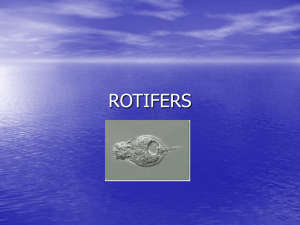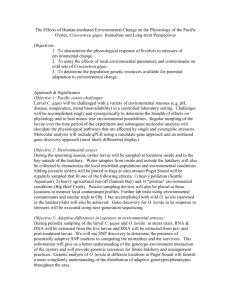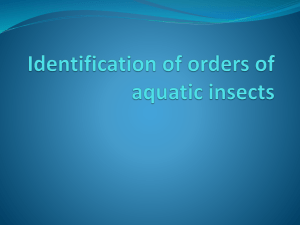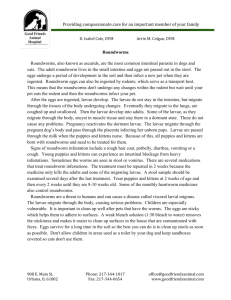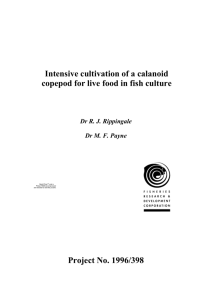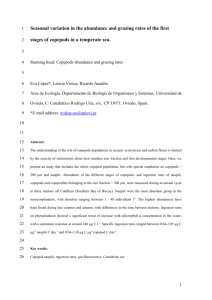期刊Journal name
advertisement
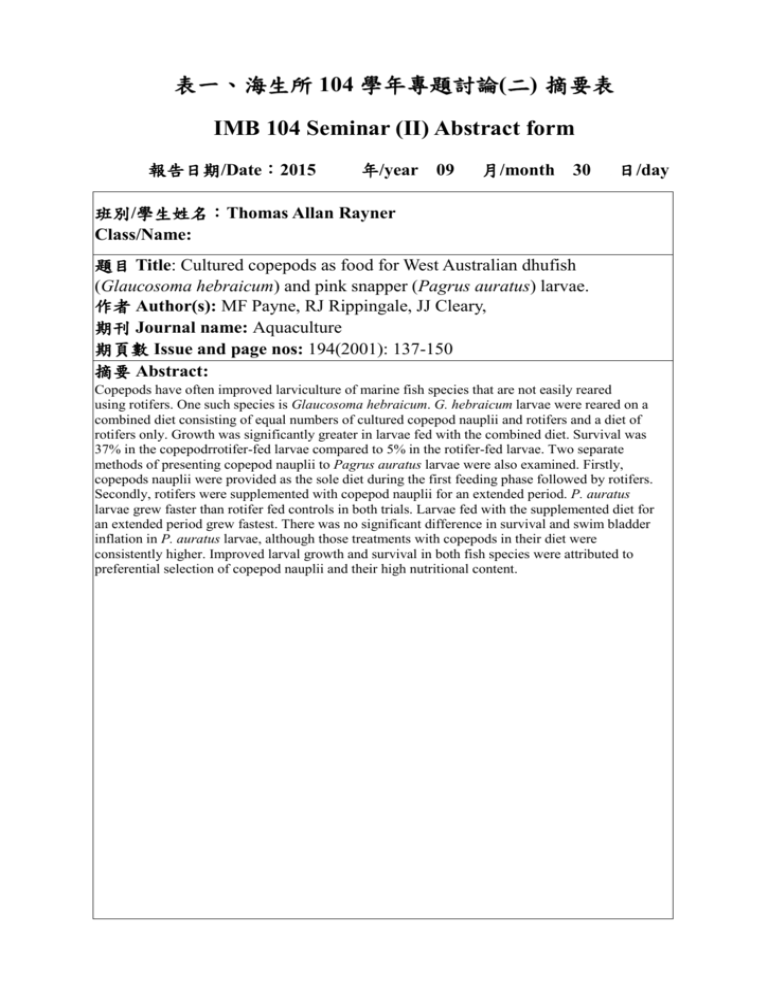
表一、海生所 104 學年專題討論(二) 摘要表 IMB 104 Seminar (II) Abstract form 報告日期/Date:2015 年/year 09 月/month 30 日/day 班別/學生姓名:Thomas Allan Rayner Class/Name: 題目 Title: Cultured copepods as food for West Australian dhufish (Glaucosoma hebraicum) and pink snapper (Pagrus auratus) larvae. 作者 Author(s): MF Payne, RJ Rippingale, JJ Cleary, 期刊 Journal name: Aquaculture 期頁數 Issue and page nos: 194(2001): 137-150 摘要 Abstract: Copepods have often improved larviculture of marine fish species that are not easily reared using rotifers. One such species is Glaucosoma hebraicum. G. hebraicum larvae were reared on a combined diet consisting of equal numbers of cultured copepod nauplii and rotifers and a diet of rotifers only. Growth was significantly greater in larvae fed with the combined diet. Survival was 37% in the copepodrrotifer-fed larvae compared to 5% in the rotifer-fed larvae. Two separate methods of presenting copepod nauplii to Pagrus auratus larvae were also examined. Firstly, copepods nauplii were provided as the sole diet during the first feeding phase followed by rotifers. Secondly, rotifers were supplemented with copepod nauplii for an extended period. P. auratus larvae grew faster than rotifer fed controls in both trials. Larvae fed with the supplemented diet for an extended period grew fastest. There was no significant difference in survival and swim bladder inflation in P. auratus larvae, although those treatments with copepods in their diet were consistently higher. Improved larval growth and survival in both fish species were attributed to preferential selection of copepod nauplii and their high nutritional content. 題目 Title: Improving Live Feeds: Effect of a Mixed Diet of Copepod Nauplii (Acartia tonsa) and Rotifers on the Survival and Growth of First-Feeding Larvae of the Southern Flounder, Paralichthys lethostigma. 作者 Author(s): JA Wilcox, PL Tracy, and NH Marcus 期刊 Journal name: Journal of the World Aquaculture Society 期頁數 Issue and page nos: 37 (1) (2006): 113-120 摘要 Abstract: With seas rapidly approaching maximum sustainable yield for most fish species, and far exceeding it for a few, production of marine species for aquaculture has become critical in orderto meet the burgeoning demand for seafood. Production aquaculture requires vast numbers of juveniles to stock in order to grow sufficient quantities of fish at commercial scale. However, the production of juveniles of many valuable marine species has proven to be difficult with the presently available early feeds. While the industry-standard early feeds are rotifers (Brachionus sp.) or brine shrimp (Artemia sp.), many marine species perform poorly or fail to survive on these diets (Jung and Clemmesen 1997; Rønnestad et al. 1998; Planas and Cunha 1999; Hamre et al. 2002). Extensive green water culture of zooplankton and larval fish has allowed some marine culture success, but this technique provides little control over water quality or introduced pathogens and parasites (Karlsbakk et al. 2003). Development of appropriate larval feeds, which enable the growth and maturation of mass quantities of target fishes from egg to juvenile, has become a focal component of aquaculture research. In recent years, studies have shown that for a number of marine fish species, diets composed of copepod nauplii result in better development, growth, nutritional content, and survival of the first-feeding larvae compared to diets consisting solely of rotifers and brine shrimp (Watanabe et al. 1983; Støttrup et al. 1986; Kraul et al. 1992, 1993; Støttrup and Norsker 1997; Schipp et al. 1999; Shields et al. 1999; Støttrup 2000; Payne et al. 2001; Evjemo et al. 2004). Southern flounder, Paralichthys lethostigma, is a prime candidate species for aquaculture. They are harvested commercially and by recreational fishermen, and they are considered excellent table fare. Their native range includes estuarine waters from North Carolina to Cape Canaveral, Florida, and from Tampa, Florida, to Southern Texas. Their capacity to tolerate a broad range of salinity has generated interest in their potential cultivation inland using hard fresh water or saline nonpotable well water, similar to what is being done with red drum (Sciaenops ocellatus). The development of intensive culture methods for the southern lounder is of great interest because of its status as a highly desirable food fish and its potential for commercial production. Although larvae of this species have been reared successfully to juveniles using rotifers and brine shrimp, the incidence of variable mortality and developmental abnormalities in early life stages has hindered attempts to produce southern flounder juveniles in large numbers (Daniels et al. 1996; Denson and Smith 1997; Benetti et al. 2001; Heyward and Smith 2001; Henne and Watanabe 2003; Moustakas et al. 2004). This study reports on the effectiveness of copepod nauplii produced in batch culture in the laboratory as a first feed for rearing southern flounder. Acartia tonsa was chosen as the test food because it is one of the locally dominant estuarine copepods, and southern flounder use estuaries for feeding during their early developmental stages (Burke 1995; Daniels 2000). Although numerous studies on prey selectivity in larval fish can be found in the literature, only a few (Naess et al. 1995; Doi et al. 1997; Toledo et al. 1999; Payne et al. 2001) tested the effectiveness of monospecific diets of copepods or rotifers versus simultaneous mixtures of copepods and rotifers or brine shrimp on larval survival and growth. Because copepod nauplii have been shown to improve larval fish performance in other species, and rotifers are an established first food for larval southern flounder, this study was designed to test a mixed diet of copepod nauplii and rotifers. In this study, we compared the survival and growth of flounder larvae fed exclusively S-type or SS-type rotifers, two strains of Brachionus rotundiformis (Hagiwara et al. 1995; Serra et al. 1998), to those fed a 50/50 diet of copepod nauplii and S-type rotifers. 題目 Title: Food Selection of Early Grouper, Epinephelus coioides, Larvae Reared by the Semi-intensive Method. 作者 Author(s): JD Toledo, SN Ggolez, M Dor and A Ohno. 期刊 Journal name: Aquaculture Science 期頁數 Issue and page nos: 45 (3) (1997): 327-337 摘要 Abstract: The grouper, Epinephelus coioides, larvae were reared in outdoor tanks with nauplii of copepods and/or rotifers, Brachionus rotundiformis as food. Nauplii propagated in tanks consisted mainly of Pseudodiaptomus annandalei and Acartia tsuensis. Gut content was examined for a total of 953 larvae sampled from day 3 to day 10 (day of hatching being day 0). Grouper larvae successfully started feeding on early stage nauplii even if their abundance was as low as ca. 100 ind./l and showed better survival and growth thereafter compared to those fed with rotifers only. Feeding incidence reached 100% on day 4 when nauplii were available and only on day 9 when rotifers were given alone. Selective feeding ability of larvae seemed to start from day 4 and the larvae thereafter preferred to feed on medium- and large-size nauplii than rotifers. Coastal calanoid copepods of the genera Pseudodiaptomus and Acartia could be reproduced in tanks and their nauplii can be used as food for marine fish larval rearing.
